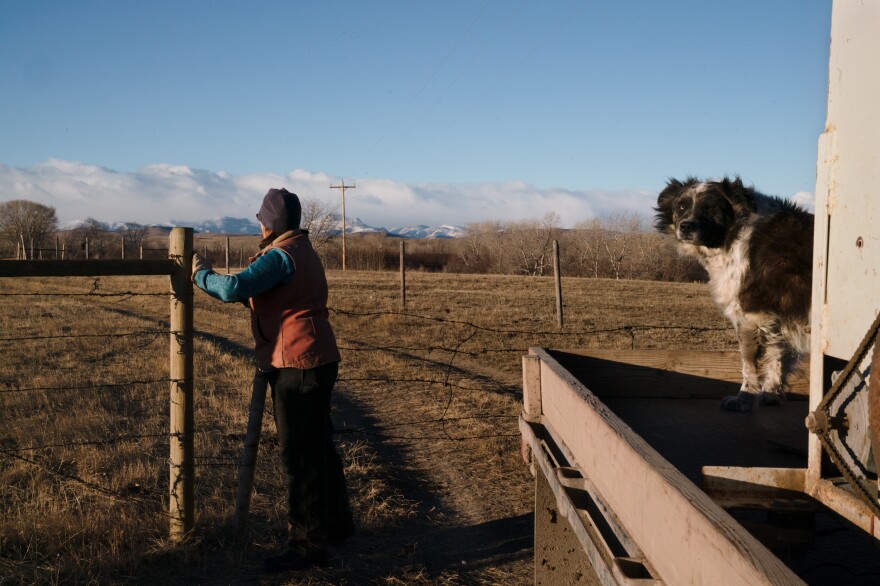Trina Jo Bradley squints down at a plate-sized paw print, pressed into a sheet of shallow snow.
She reaches down with fingers outstretched, hovering her palm over a sun-softened edge. Her hand barely covers a third of the track.
"That's a big old foot right there," she says, with a chuckle. "That's the one where you don't want to be like: 'Oh! There he is right there!"
Bradley, like many ranchers, applies a wry sense of humor to things that feel out of her control.
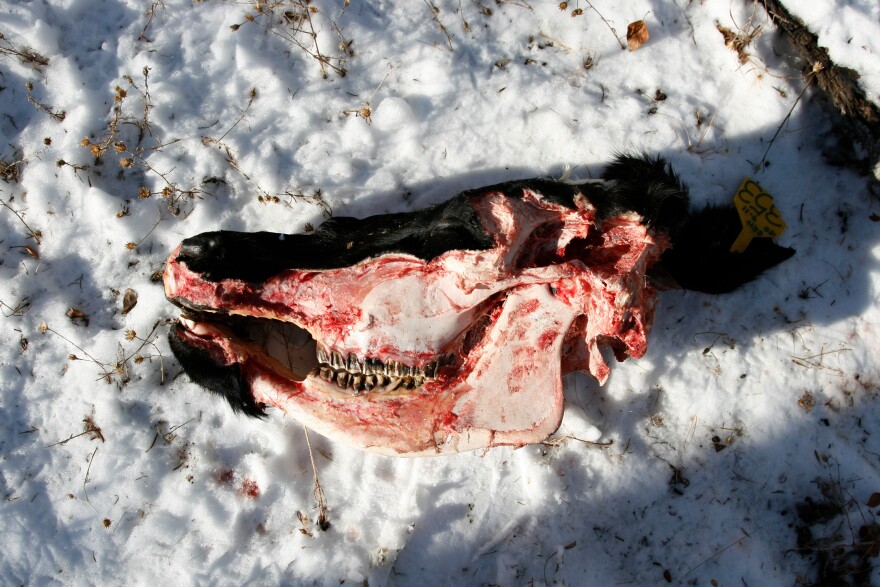
Growing up here on the Rocky Mountain Front, where prairie meets mountain, she rarely saw grizzlies. Now, she sees them all of the time. Some nights, her family watches the massive carnivores lumber by outside their living room window. Bradley says they're majestic.
"As long as they mind their own business and stay out of my cows, I could really care less if they're here," she says. "I enjoy having them here and I think most ranchers do."
Like most ranchers, Bradley and her husband have been largely accommodating of grizzly bears as their population has rebounded and they've spread from the mountains into the more-populated plains. They've started storing food for their cattle in a raised, bear-proof container. Neighbors have lined entire pastures with electric fencing. Bradley's daughter now knows not to leave the yard.
But frustration is growing.
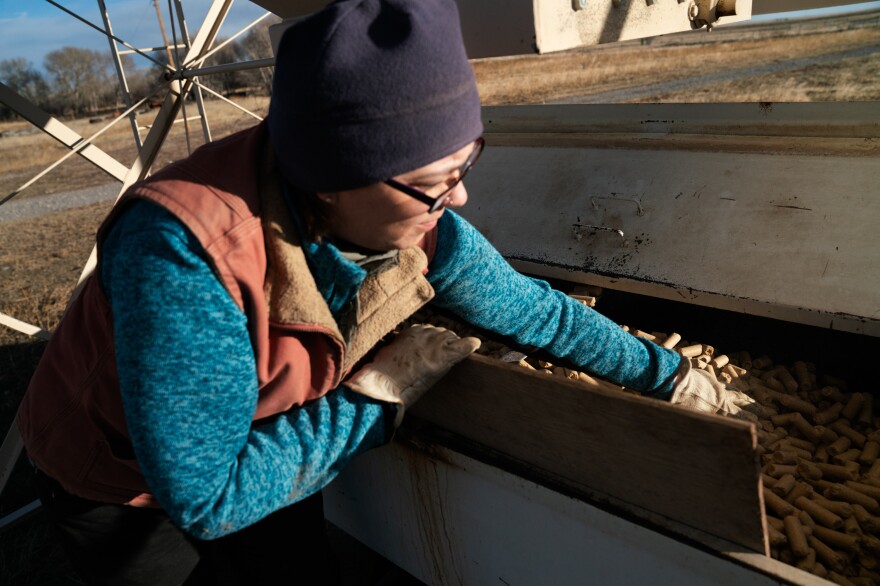
Since being listed as threatened under the Endangered Species Act in 1975, grizzly bear populations in northwest Montana and the Greater Yellowstone Area have more than tripled in size, thanks, in no small part to a hard-earned tolerance and efforts from people like Bradley to reduce conflict between human and bear.
That tolerance, scientists and wildlife officials say, is key to the grizzly bears' future as the effects of climate change harden, the West gets more crowded, and bears spreads into areas they haven't been in more than 100 years.
Bradley's tolerance is waning.
The bears have nothing to do with it.
The source of her frustration is a feeling that her opinion doesn't matter and that the landmark law that brought grizzly bears back is being misused.
"I would like to see the Endangered Species Act do exactly what it was written for," she says. "And when a species is recovered, it's done. And then it goes to the state to manage it."
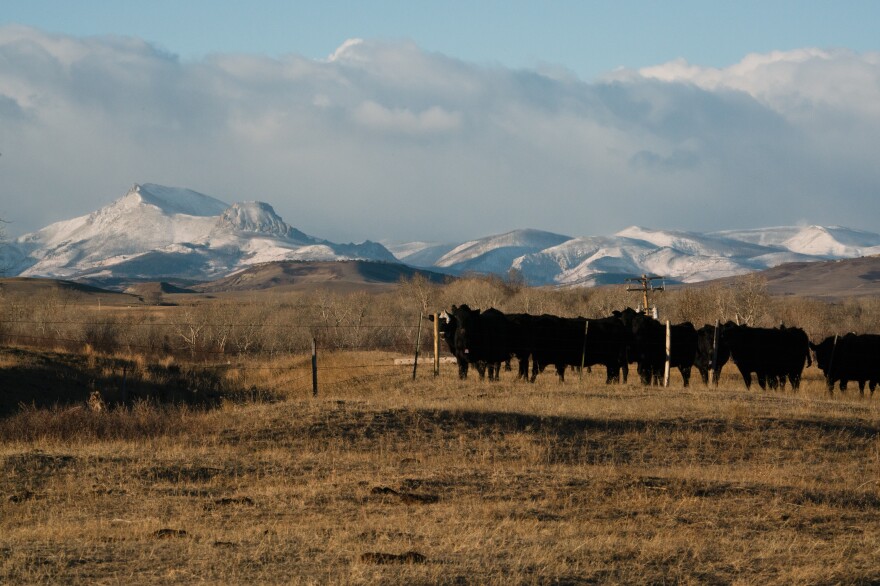
Better than expected recovery
When Chris Servheen was named the nation's first grizzly bear recovery coordinator, tasked with saving and restoring the iconic species, he wasn't optimistic.
There were just a few hundred of the mammoth mammals left in the lower 48 U.S. states, holed up in the confines of Yellowstone National Park and a few wilderness areas along the Canadian border. People were encroaching on most sides, many of them not keen to be cohabiting with an animal that the Department of Interior aptly described as being "highly intolerant of man."
Six years earlier, the U.S. Fish and Wildlife Service had intervened, placing strict federal protections on grizzly bears in the contiguous U.S.
It was Servheen's job to bring the bears back to the point where those federal protections weren't needed.
Quietly, he thought he'd be presiding over their demise.
Grizzly bears are slow to reproduce. They require massive amounts of habitat. "And they kill people," Servheen says, in the matter-of-fact tone that earned him admirers and enemies during a 35-year career.
What followed, though, exceeded his and most people's expectations.
With federal protections in place, wildlife officials and conservation groups set out to change attitudes and build tolerance for the bears. They started programs to reimburse ranchers for livestock that bears killed. They closed roads in bear habitats and fenced in landfills.
Grizzly populations in the Yellowstone region and northwest Montana flourished. Today, there are an estimated 1,400 to 1,700 grizzly bears in the contiguous U.S.
"The Endangered Species Act works,"says Servheen, now retired. "We proved it with grizzly bears."
In 2007, the U.S. Fish and Wildlife Service declared success, removing endangered species protections for Yellowstone-area grizzlies. Lawsuits from wildlife groups and tribal governments quickly followed and two years later federal protections were put back in place, after a federal judge decided that the agency hadn't adequately considered the impacts of climate change on the bears' food sources.
In 2016, as Servheen was retiring, his agency tried to delist the bears again. Again, it failed.
A federal judge restored endangered species protections to Yellowstone-area grizzlies last fall, just hours before a highly-controversial hunt of the bears was scheduled to start in Wyoming and Idaho. An effort to delist grizzlies in northwest Montana was paused as well.
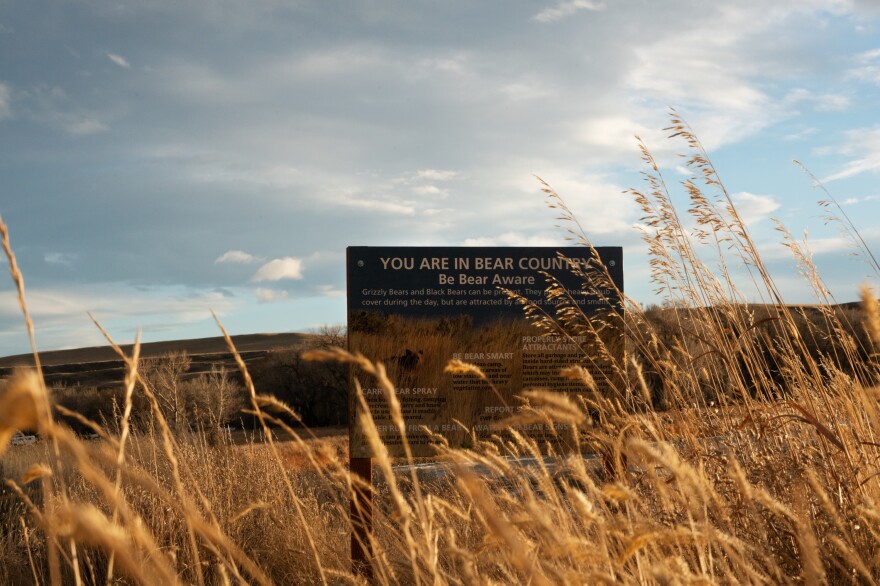
The U.S. Fish and Wildlife Service filed a notice to appeal the latest court decision last December, but a resolution could take years.
To some who support delisting, the back-and-forth doesn't seem like that big of a deal.
"I don't doubt that some people are very frustrated, but the consequence of not delisting grizzly bears is the continuation of good and effective programs," says Tom France, a long-time conservationist with the National Wildlife Federation's Northern Rockies, Prairies and Pacific Regional Center.
Many people who live in grizzly bear country, he points out, are continuing to work with conservation groups and wildlife agencies to protect the bears.
To Servheen, the danger seems more acute. He worries that the delay will erode public support for the Endangered Species Act and, more importantly, for the bears themselves.
"The future of grizzly bears is in the hands of the people who live, work and recreate in bear habitat," he says. "And if those people feel that no matter what they do, nothing's ever going to change, nothing's ever good enough, then they won't invest the time in helping with recovery."
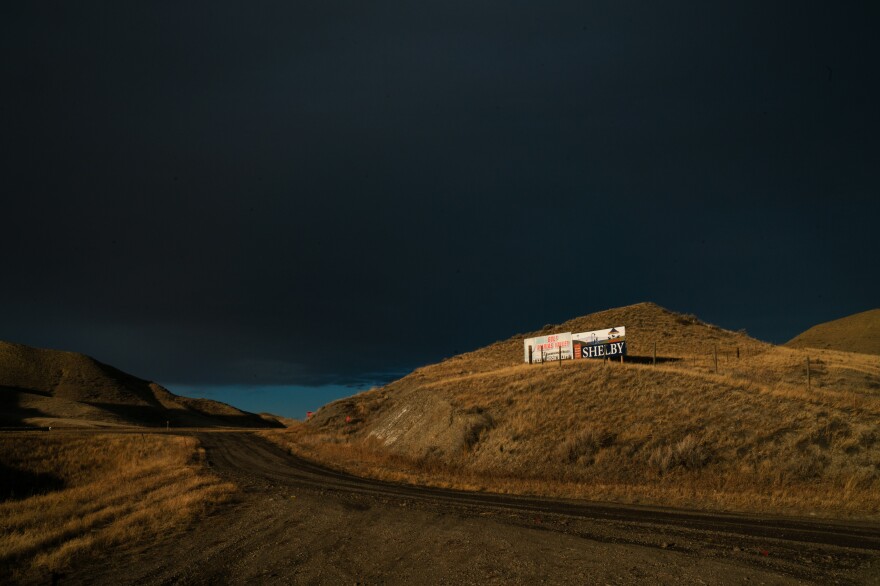
"People ... feel that their rights are being infringed upon"
Wesley Sarmento always keeps his cell phone on him, even though he's often out of cellular service.
As a bear management specialist for Montana Fish, Wildlife and Parks, stationed in the rural, agriculture-rich Rocky Mountain Front, he gets calls all the time.
"I've gotten calls at four in the morning. I've gotten calls at 8pm on a Friday night," Sarmento says. "Usually bears in people's yards, eating apples, dog food — finding food mainly."
Conflicts between humans and bears have been on the rise in recent years. Grizzlies, almost always, end up on the losing end.
Last year, scientists counted 51 grizzly bear mortalities in northwest Montana, making it the deadliest year since they started keeping track.
Sarmento's job is to try and reduce those conflicts and deal with the ones that occur. He speaks at town meetings and teaches bear safety at public schools, preaching tolerance and listening to complaints. He removes livestock carcasses from ranches.
When a conflict arises, Sarmento is the person who responds, but he doesn't always get final say.

Because grizzly bears are still federally protected here, Sarmento has to call federal wildlife officials before he takes certain actions, like relocating a bear or setting up a trap. It can be annoying at times, he says, but he usually doesn't mind.
The power dynamic doesn't go unnoticed by ranchers though, many of whom are already suspicious of the federal government.
Bradley thinks it's ridiculous that Sarmento has to check in with his federal counterparts, and believes that state biologists — free of federal oversight — would be better able to respond to problem bears.
Sarmento and others say that little would change. "Things would be streamlined," he says.
Critics of delisting grizzly bears worry that state management would mean more dead bears, and they're right, in that state management would undoubtedly include hunting.
Wyoming and Idaho had issued permits to hunt 23 grizzlies last fall, before the federal judge's decision restored federal protections for the bears. Montana held off on granting a hunting season, but few doubt that the state would soon do the same.
State wildlife managers say that hunting is an important part of wildlife management and that it would be carried out in a responsible, highly-regulated way. If bear populations fell below a certain threshold, they'd be relisted.
Bradley could care less about hunting. Her frustration is more about what she sees as a broken promise, and a feeling that she has no say in how bears are managed.
Sarmento hears that frustration from a lot of the locals he interacts with. Some, he says, have even stopped collaborating with him on projects.
"I certainly hear some animosity to the Endangered Species Act, because people that are living with endangered species feel that their rights are being infringed upon," he says. "That recovery goals are going beyond what was originally agreed to."

Disagreement over what recovery means
The question of what constitutes recovery — how many bears there needs to be and where — is at the heart of the grizzly bear delisting debate and it's a difficult thing to answer, because it involves much more than just science.
The Endangered Species Act says a species is recovered when it is no longer in danger of extinction throughout all or a significant portion of its range, and when it's unlikely to become so "within the foreseeable future."
That leaves a lot of room for interpretation.
And interpretations vary widely.
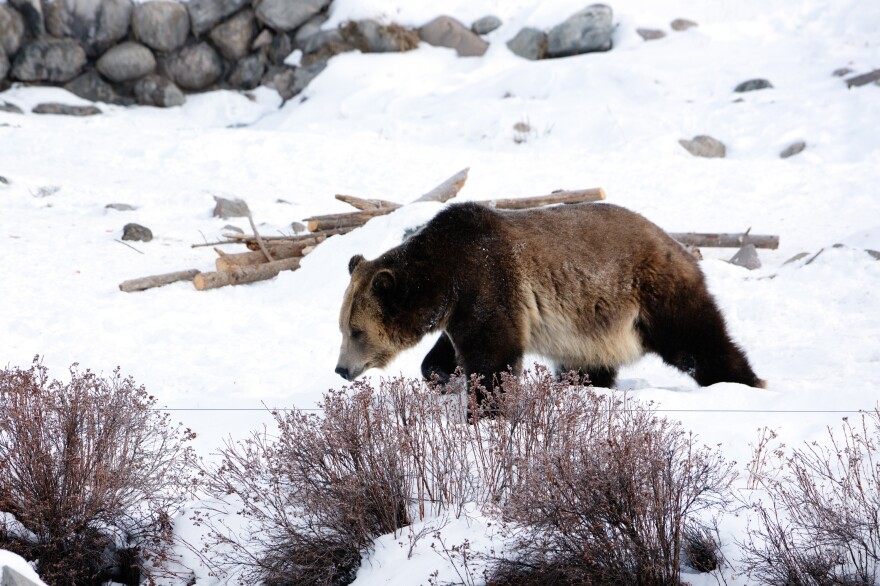
In 1993, a panel of federal, state, tribal and local biologists and stakeholders, called the Interagency Grizzly Bear Committee, put out a recovery plan for grizzly bears in the lower 48 states. It set population targets for each of the five populations of grizzlies still living south of Canada.
For Yellowstone-area bears, the goal was 500 bears. When they were listed as threatened in 1975, there were as few as 136 bears left. Today, scientists estimate there are more than 700 bears in the ecosystem.

Some wildlife groups and grizzly advocates question those numbers and the federal government's population counting methodology. Others believe the initial recovery goals were set too low.
"I think the people that are litigating this, for the conservation groups, it's about what recovery means and what your vision of that is going to be in the future," says Jeremy Bruskotter, a professor at the School of Environment & Natural Resources at Ohio State University. "Is it curating populations in isolated wilderness areas, or restoring them to wide areas of their historic range?"
Grizzly bears used to live from Alaska to central Mexico, ranging from the Pacific Coast to Missouri. Today, they only inhabit 2 percent of that historic range, living in isolated pockets.
The lack of connectivity between populations was a main reason the federal judge restored endangered species protections for the bears late last year. Isolated populations don't have much genetic diversity and there are concerns that a hunt of the animal would prevent them from linking together.
Wildlife officials believe those connections will happen naturally, over time. Grizzly bears are venturing further afield, they point out, entering places they haven't been for generations.
"The Greater Yellowstone Ecosystem has reached its carrying capacity for bears. It's exporting bears," says Dan Ashe, director of the U.S. Fish and Wildlife Service under President Barack Obama. "The question this point around, about whether they should be delisted, is more of a values-based question."
It's less a question about the Endangered Species Act, he says, and more a question about the ethics of trophy hunting, or what a person views as an acceptable number of bears.
"That's a perfectly legitimate conversation to have," Ashe says. "But having that discussion around the delisting process feeds this dialogue that the Endangered Species Act is broken, and that once a species goes on the list it is difficult to impossible to get it off. And, in the long run, that doesn't help the bear, or the prospect of conservation of threatened and endangered species."

Legislative attacks, public support
The narrative that Ashe is referring to — that the Endangered Species Act is flawed because animals don't come off it — is a popular one with Congressional Republicans and others opposed to the law.
In part, because there's some truth to the argument.
In the 45-year history of the Endangered Species Act, fewer than 2 percent of species that have been listed have been recovered and removed.
"As a doctor, if I admit 100 patients to the hospital and only three recover enough under my treatment to be discharged, I would deserve to lose my medical license," said Sen. John Barrasso, R-Wyo., Chairman of the Senate Committee on Environment and Public Works, during a hearing on the Endangered Species Act last year.
The criticism ignores some other relevant information, though.
Conservation takes a long time. It took hundreds of years for grizzly bears to be hunted, trapped and driven to the brink of extirpation from the lower 48 states. Scientists and conservationists say it's unreasonable to expect that they'd recover in a few decades.
It also ignores the fact that the Endangered Species Act has been incredibly successful at accomplishing its main goal: preventing extinction. Ninety-nine percent of the animals that have been listed under the act still exist today.
Still, in the last Congress, there were 116 attacks against the Endangered Species Act, according to the Center for Biological Diversity. Bills and riders added to them were proposed to delist specific species, limit habitat protections, and to block funding for species like the New Mexico meadow jumping mouse. None passed into law.

"All of these riders and all of these standalone bills keep failing and I think that's because public support for the Endangered Species Act is actually very, very high," says Bethany Cotton, wildlife program director for WildEarth Guardians, an environmental group that sued to keep grizzly bears listed.
A recent study found that the vast majority of Americans, regardless of region or political ideology, support the landmark environmental law. The legal back-and-forth on grizzly bear delisting seemed to have no discernible impact, the study found.
"That concern [that not delisting species hurts the Endangered Species Act] has been sort of a threat that has been leveled for more than a decade and we haven't seen it been proven true," Cotton says.
There is one notable exception though.
In 2011, following a years' long, highly-contentious back-and-forth on the delisting of grey wolves — similar to what's happening now with grizzlies — Congress took an unprecedented step.
A bipartisan measure, proposed by Sen. Jon Tester, D-Mont., and Rep. Mike Simpson, R-Idaho, was attached to a budget rider that stripped endangered species protections from grey wolves in their home states.
It was an extraordinary step that some worried would set a dangerous precedent.
Despite loud opposition, the measure passed.

It was the first and only time Congress sidestepped the Endangered Species Act, delisting a species on its own. Others have since tried to follow suit.
In the last Congress, lawmakers proposed to delist a species of jumping mouse, Mexican wolves, the American burying beetle, freshwater mussels and grizzly bears.
The grizzly bear proposal, by Rep. Liz Cheney, R-Wyo., would have directed the Interior Department to delist the bears in the Great Yellowstone Ecosystem and prohibit future judicial review.
"We don't want to have Congress becoming the arbiters over the fate of species," Ashe says. "The longer this lingers, the more likely it is that people will try to find a political solution."
"You're wasting your time"
Trina Jo Bradley stands up in the back of a crowded conference room and squints down at a set of scribbled notes.
"Hi, my name is Trina Bradley and I'm the vice president of the Marias River Livestock Association," she begins. "We have our share of bears."
Bradley drove more than 220 miles from her ranch to address the crowd. She'll speak for less than two minutes.
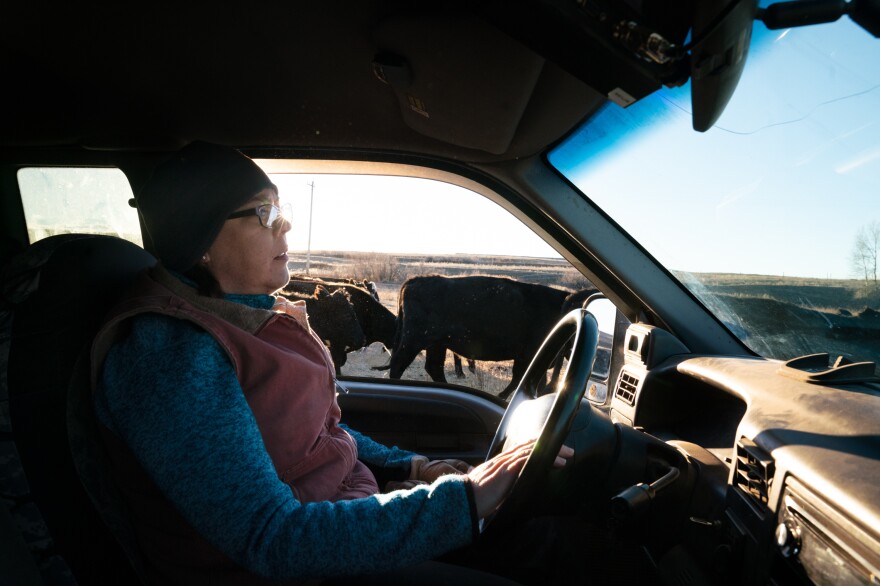
The wildlife officials gathered at the front of the room know her. She speaks at nearly every grizzly bear planning and committee meeting in the state, pressing lawmakers and federal and state biologists about their plans with the bears.
Years ago, her dad came to a meeting with her and never came back again.
"You're wasting your time," he told her. "They don't care."
The frustration built to the point that he and some of his neighbors don't even call bear biologists anymore when they need to, Bradley says. They don't see the point.
They're so far past the end of their rope, she says, "they can't even see it anymore."
Bradley isn't there yet. She still comes to these meetings and works with local biologists, representing her neighbors and others who've long since given up.
She looks back down at her script.
"There are two things that will win you points with ranchers like me," she reads. "Empathy and results."
Copyright 2023 NPR. To see more, visit https://www.npr.org.
